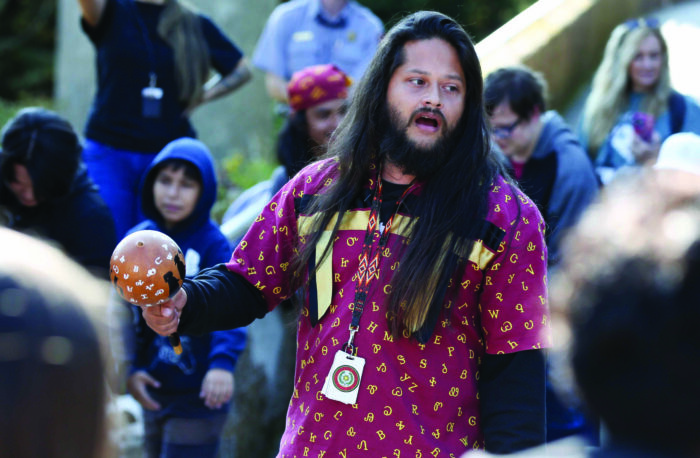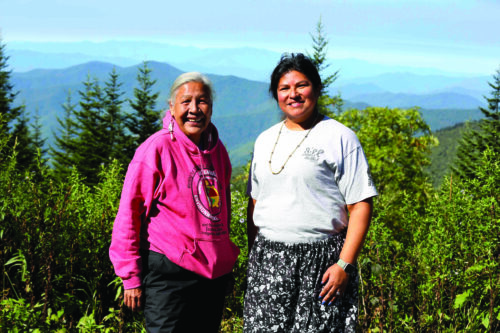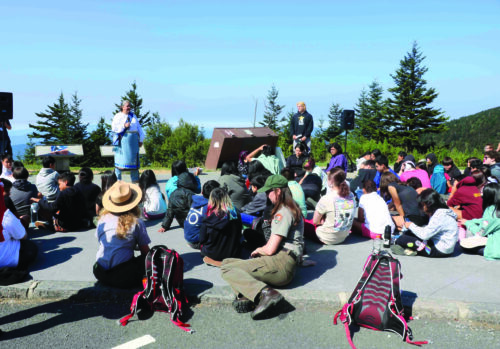
During the Kuwohi Connection Days event, Dylan Morgan, Museum of the Cherokee People Atsila Anotasgi cultural specialist and an EBCI tribal member, leads a Cherokee Friendship Dance with the students at the top of Kuwohi on the morning of Tuesday, Sept. 10. (SCOTT MCKIE B.P./One Feather photos)
By SCOTT MCKIE B.P.
One Feather Asst. Editor
KUWOHI – As the sun glistened off of the clouds hanging in the valley at Kuwohi, mulberry place, on the morning of Tuesday, Sept. 10, students were learning about the history of the site that is special to the Cherokee people.
Kuwohi Connection Days, a joint venture between the Great Smoky Mountains National Park and the Eastern Band of Cherokee Indians (EBCI), provided educational experiences and knowledge about the special mountain for students in various schools which went on different days over a three-day period including: Cherokee Central Schools fifth graders and seniors, New Kituwah Academy, Robbinsville Elementary School fifth graders, Robbinsville High School students in a Cherokee History class, Smokey Mountain Elementary School fifth graders, and Swain Co. High School seniors.

Mary Crowe and Lavita Hill, both EBCI tribal members, have spearheaded the effort to officially change the name of Clingman’s Dome to Kuwohi. They educated the students during the events on this effort and even had a copy of the actual application they submitted to the U.S. Board of Geographic Names who will meet on the issue on Sept. 18.
Lavita Hill and Mary Crowe, both EBCI tribal members, have spearheaded the effort to officially change the name of Clingman’s Dome to Kuwohi. They educated the students during the events on this effort and even had a copy of the actual application they submitted to the U.S. Board of Geographic Names who will meet on the issue on Sept. 18.
During Tuesday’s event, Hill said, “Our goal all along has just been to educate. To say, ‘what is Kuwohi? Why is it significant to our people?’ and then to share that with everyone, anyone that wants to listen.”
She added, “This mountain is Kuwohi. It’s named Clingman’s Dome, but it has always been Kuwohi and now we’re asking the U.S. government to change it back to Kuwohi.”
Malia Crowe Skulski, GSMNP resource education and an EBCI tribal member, was instrumental in the planning of the event. “We feel the day went exceptionally well. It was like a beautiful dance, with everyone and every element in motion, yet flowing seamlessly together. Of course, there were a few bumps along the way, but thanks to the thoughtful planning with the Kuwohi Planning Committee and teachers since January, we were well-prepared. It was incredible to witness how the Cherokee Central School seniors embraced the mission of the day and took on the responsibility of being mentors and role models for the 5th graders.”
She outlined the goals for Kuwohi Connection Days as follows:
- Community and Collaboration (Gadugi): To strengthen the bonds within the community by encouraging a collaborative spirit. We aim to demonstrate the importance of working together (Gadugi) for the collective benefit, as well as for individual growth and support.
- Cultural Education and Connection: To provide students with a deep understanding of the Cherokee people’s historical and cultural connections to Kuwohi (Clingman’s Dome) and the surrounding lands. This includes fostering a sense of place
- Environmental Stewardship: To instill a respect for nature and the environment by highlighting the significance of Kuwohi as a place of refuge, spiritual significance, and ecological importance. We aim to inspire a commitment to preserving these lands for future generations.
- Restoration and Correction: To educate about the historical importance of Kuwohi and the ongoing efforts to restore and correct its name and significance. This includes acknowledging the area’s importance as part of the Cherokee traditional homelands and correcting the narrative that may have been altered over time.
- Youth Engagement: To involve the youth in meaningful ways, ensuring they understand the significance of their cultural heritage and are inspired to carry these traditions forward.
Skulski further commented, “It was truly magical and one of the most meaningful experiences of my life to witness students, community members, teachers, and park staff all coming together for such a significant and historic event. It was awe-inspiring to see elders and youth share in the experience and reclaim space at Kuwohi, a place so sacred to our people.”
Staff from the Museum of the Cherokee People educated the students about Cherokee clans and also led Cherokee dances at the top of Kuwohi.

Nancy Pheasant, standing left, a storyteller and member of the Eastern Band of Cherokee Indians, tells students stories about Kuwohi.
Prior to leading several dances on Tuesday morning, Dylan Morgan, Museum of the Cherokee People Atsila Anotasgi cultural specialist and an EBCI tribal member, told the students, “There was a lot of importance to our culture that came from this place.”
He praised the idea for the event itself saying, “To me, I think it’s really cool that we get one chance out of the year to close this mountain down completely with no tourists up here for us to be able to come up here and enjoy this place. That’s very special to me.”
Nancy Pheasant, an EBCI tribal member and a storyteller, told the students on Tuesday, “What does it mean to be Cherokee? What does it mean to you? It could be the place where you were born. It could be the place where you live. But, it should mean so much more than just a place. It should mean us as people, or us as individuals. So, what it means to be Cherokee can be made up from a lot of different things – not only who we are or where we come from, but also our language that we speak, our way of thinking, the way we live today.”
She went on to speak about Kuwohi commenting, “This place is a place of balance. This place is a place of harmony. And, it’s also known for its magic, for its medicine that we have here.”
Several other tribal programs and entities were present including: Igali Puppets, Remember the Removal Riders, EBCI Cooperative Extension, and the Cherokee Community Club Council.





